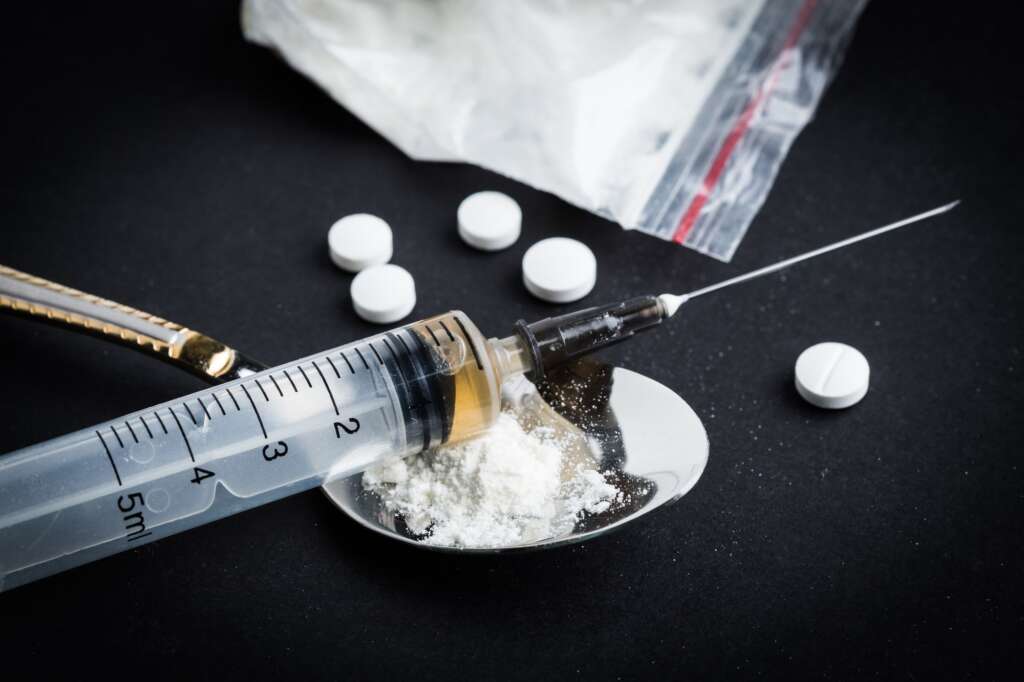What Is Addiction?
Drug addiction is a chronic disease that impacts the brain and behavior, making it difficult to control drug use. This is because addictive drugs trigger the brain’s reward system, creating intense feelings of pleasure and euphoria that encourage repeated use. Chronic drug abuse can cause physical dependence, resulting in withdrawal symptoms or drug cravings when the drug isn’t in your system.
Being able to identify the most addictive drugs can help you better understand their harmful effects and help someone who may be struggling with a substance use disorder. Keep reading to learn about seven of the most addictive drugs and their effects on the brain and body.

The Top 7 Most Addictive Drugs
Heroin
Heroin is an illegal opioid drug derived from morphine that taps into the brain’s opioid receptors. This highly addictive substance can be injected, smoked or snorted and comes in the form of a brown or white powder or a sticky black substance referred to as black tar. Injecting heroin is extremely dangerous and can result in contracting HIV or hepatitis C or in collapsed veins.
When consumed, heroin stimulates a rush of dopamine in the brain, alleviating pain and increasing relaxation and euphoria. This rush can result in warm, flushed skin, dry mouth, and heaviness in the limbs. Individuals may feel drowsy for several hours afterward and experience slowed mental, breathing, and heart functions.
According to the National Institute on Drug Abuse, about 1 million people struggle with heroin addiction. Although heroin carries a high potential for abuse, several treatments are available. These include behavioral therapies and medications, such as methadone, naltrexone, and buprenorphine, that can reduce cravings and severe withdrawal symptoms during detox.
Cocaine
Cocaine is an addictive stimulant drug derived from the coca plant in South America. As a common street drug, it comes in a powder or crystal form referred to as crack cocaine. Smoking crack cocaine produces a quicker, more intense high than snorting powder cocaine because it immediately crosses from the lungs to the bloodstream.
Cocaine high increases dopamine levels, producing strong pleasurable feelings. Individuals may experience extreme happiness, increased alertness, paranoia, or hypersensitivity to sight, sound, and touch. Cocaine also temporarily decreases the need to sleep or eat, which is why many find that it helps them perform simple tasks more quickly. In 2021, 4.8 million people reported using cocaine in the past year, while about 1.4 million people had a cocaine addiction.
Drug addiction treatment programs usually recommend a combination of behavioral therapies and medication-assisted treatment (MAT) for cocaine addiction. Although there are currently no FDA-approved medications to treat cocaine abuse, various drugs used to treat other addictions, such as disulfiram for alcohol abuse, have shown promise.
Methamphetamine
Methamphetamine, or crystal meth, is another addictive stimulant drug that can be smoked, snorted, or injected. Meth is known for being extremely potent and dangerous, despite causing an intense, euphoric high that provides users with a boost of energy and confidence. It releases more dopamine in the brain than other drugs, making meth notoriously difficult to quit.
Long-term meth use can cause brain changes in areas associated with memory and emotion. Many users experience emotional and cognitive issues, such as anxiety, confusion, or delusions. It can also result in several physical changes, including extreme weight loss, rotting teeth, itchy skin, and loss of appetite. In 2021, about 2.5 million people reported using meth within the past year, and over 32,500 people died from an overdose involving meth.
Behavioral therapies, including cognitive behavioral therapy (CBT) and contingency management, are considered the most effective treatment options. There are currently no prescription drugs that have successfully combated methamphetamine addiction.
Nicotine
Nicotine is a legal stimulant widely available as tobacco products, e-cigarettes, and vapes. When nicotine is inhaled, it floods receptors in the brain, creating an instant buzz. You may experience an increase in blood pressure, heart rate, and blood flow to the heart. This addictive drug can harm almost any organ in the body and has been linked to several cancers, lung issues, and heart disease.
Research shows nearly 40 million U.S. adults smoke cigarettes and around 3 million adolescents use at least one tobacco product. There are numerous behavioral therapies and FDA-approved medications for nicotine addiction, including over-the-counter nicotine replacement therapies such as gum or lozenges.
Alcohol
Alcohol is a depressant that slows down the central nervous system, resulting in lowered blood pressure and heart rate. It also affects motor skills and cognition, causing mood swings and impaired decision-making or impulse control. Out of all addictive substances, alcohol is the most widely used because it’s legal and considered socially acceptable.
According to the 2021 National Survey on Drug Use and Health, about 29.5 million people aged 12 and older struggled with alcohol addiction. Alcohol withdrawal symptoms can range from mild to life-threatening, making the drug hard to quit without professional treatment.
Inpatient rehab and 12-step programs are common types of alcohol abuse treatment. Many treatment programs use a combination of behavioral therapies such as CBT and prescription medications to manage withdrawal symptoms and prevent relapse.

Prescription Opioids
Prescription opioids are painkillers commonly prescribed to relieve severe or chronic pain for various medical conditions. An addiction forms when someone continues taking the medication when it’s no longer medically necessary or outside a doctor’s instructions. Individuals may crush pills or open capsules to snort the powder or dissolve it into a liquid for injection. Common prescription opioids people become addicted to include:
- Codeine
- Fentanyl
- Oxycodone
- Hydrocodone
- Methadone
Similar to heroin, prescription opioids affect opioid receptors in the brain, triggering the release of dopamine and providing pain relief. Although prescription opioids can make you feel relaxed and happy, they can also cause drowsiness, confusion, nausea, and slowed breathing, which can cause hypoxia. This condition occurs when not enough oxygen reaches the brain and can result in severe neurological effects, including permanent brain damage, coma, or death.
In 2021, about 8.7 million people reported abusing prescription painkillers. The most common addiction treatment method is combining behavioral therapy with medications, including methadone, naltrexone, or buprenorphine, to reduce cravings and normalize brain chemistry.
Benzodiazepines
Benzodiazepines are commonly prescribed to treat mental health conditions, such as anxiety or panic disorders. They produce a euphoric high that eases feelings of worry and nervousness. Although these drugs are tightly regulated, they’re some of the most commonly abused prescription drugs and extremely habit-forming. Doctors may prescribe them for use as needed or at lower doses to prevent addiction. Common benzodiazepines include:
- Xanax
- Valium
- Ativan
- Klonopin
These drugs can cause numerous side effects, including fatigue, impaired motor coordination, slurred speech, blurry vision, mood swings, and erratic behavior. They also slow down central nervous system activity, affecting emotions, rational thought, memory, and breathing. By slowing down nerve signals, the drugs may cause individuals to experience slowed reflexes, making it difficult to do certain tasks safely, such as driving.
Research from 2015 to 2016 concluded about 12.5% of American adults used benzodiazepines, but only 2.1% reported misuse and less than 1% met addiction criteria. Evidence-based treatments, such as medical detox, behavioral therapy, and medication, are often effective in treating benzodiazepine addiction.
Get Help at Anchor Addiction and Wellness Center
Using any of these addictive drugs can lead to physical or psychological dependence, increasing your risk of developing substance use disorders. Once the body becomes dependent on a substance, quitting becomes exponentially harder due to drug cravings and withdrawal symptoms that kick in once usage stop. This is why seeking addiction treatment is crucial.
Anchor Addiction and Wellness Center in Ohio offers various substance abuse treatments, including MAT, crisis intervention, and behavioral therapies. If you or someone you know is struggling with an addiction, don’t wait to seek help. Contact us today by calling (866) 900-1069 to schedule a consultation and begin your recovery journey.
